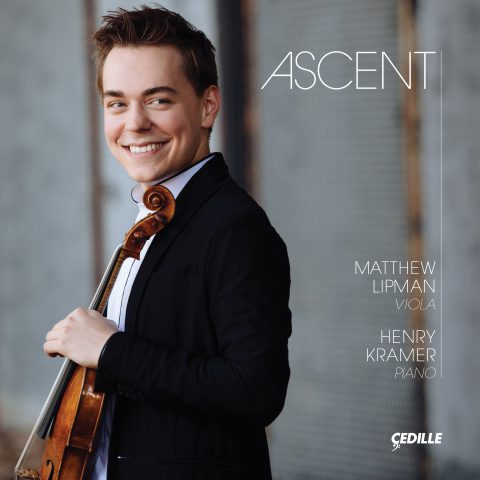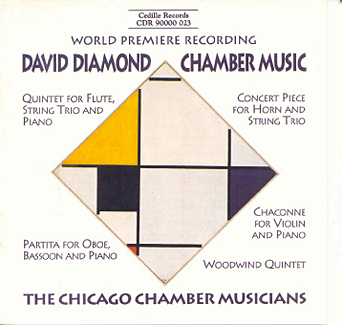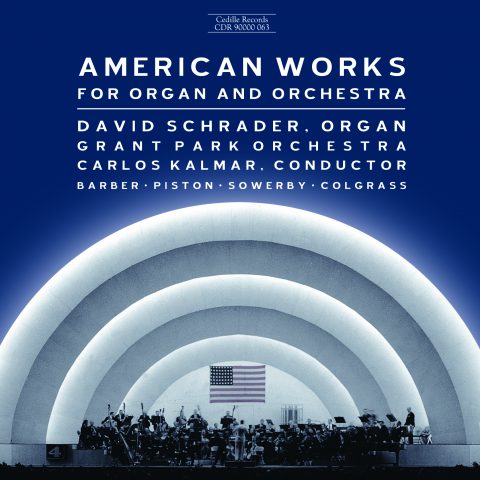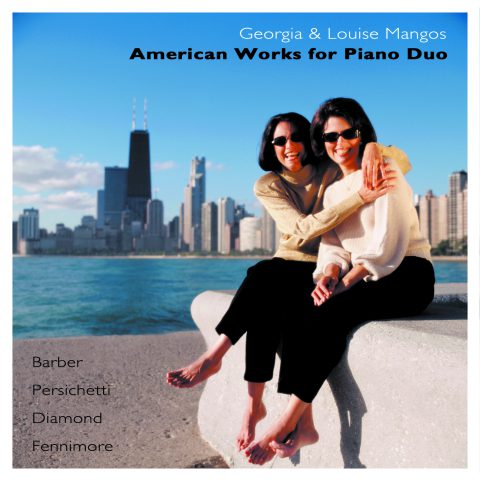Store
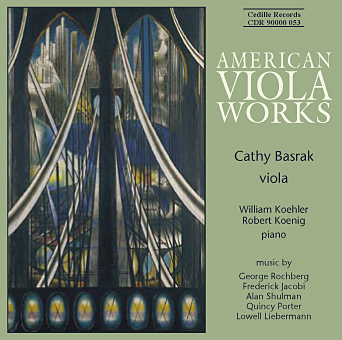
Cathy Basrak, the 23-year-old newly appointed assistant principal violist of the Boston Symphony Orchestra and principal violist of the Boston Pops Orchestra, makes her recording debut with an all-American program of attractive twentieth-century chamber music that’s rarely heard — and largely unfamiliar even to many violists.
Rochberg’s Sonata, a highly expressive, romantic work from his post-serial period, is lyrical yet intellectually stimulating. It was commissioned to celebrate the 75th birthday of viola phenomenon William Primrose.
Jacobi’s 1941 Fantasy for Viola and Piano synthesizes classical, romantic, and modern influences with melodies that recall Jacobi’s Jewish heritage. Ms. Basrak calls the Fantasy “the most difficult piece I’ve played on the viola.” Likening it to Paganini’s violin music, she says it demands virtuosic playing and dramatic expression extending to “all extremes of the spectrum.”
The most familiar work on the CD (other than the Rochberg) is Shulman’s Theme and Variations. A fixture of the standard viola repertoire, it’s unabashedly romantic in style but rich in substance. Impressionistic reveries alternate with rapid-fire passages of daunting difficulty. (In 1999, Ms. Basrak performed the orchestral version as soloist with the Philadelphia Orchestra and conductor Luis Biava — the result of her having won a student competition.)
Porter, a Connecticut native who studied composition in Paris with Vincent D’Indy, wrote extensively for strings. His sunny Speed Etude, commissioned as a virtuosic tour de force for Paul Doktor, is infused with an ebullient postwar optimism.
Liebermann’s Sonata for Viola and Piano is an enchanting piece that’s by turns ethereal and jazzy. Hailed as “one of America’s most gifted ‘new tonalist’ composers” (Time), the 39-year old New Yorker’s music has been performed by Mstislav Rostropovich, James Galway, James Levine, and Leonard Slatkin.
Ms. Basrak assembled the program herself after combing music libraries for substantial viola pieces by American composers. “My orchestral colleagues and friends weren’t familiar with a lot of this work,” Ms. Basrak says. “They were inspired to know there is American music of this quality [for viola].” To gain insights, she met with two of the three living composers represented on the CD — Mr. Rochberg and Mr. Liebermann — and corresponded with the ailing Mr. Shulman’s son Jay. “The whole experience amounted to so much more than finding music music to put on a recording,” she says. “It was more of a personal journey.” She recalls Mr. Rochberg’s passionate enthusiasm for his sonata: “He had such commitment to what he had written,” she says. “He related his music to me as if he had written it yesterday. It was still so fresh in his mind.”
Preview Excerpts
GEORGE ROCHBERG (b. 1918)
Sonata for Viola and Piano
FREDERICK JACOBI (1891-1952)
ALAN SHULMAN (b. 1915)
QUINCY PORTER (1897-1966)
LOWELL LIEBERMANN (b. 1961)
Sonata for Viola and Piano
Artists
Program Notes
Download Album BookletAmerican Viola Works
Notes by Cathy Basrak
George Rochberg (b. 1918) studied composition at the Mannes School of Music and the Curtis Institute. In 1948, he joined the faculty at Curtis, then taught at the University of Pennsylvania, retiring in 1983 as Annenberg Professor of the Humanities Emeritus. His many honors include a 1950 American Academy in Rome Fellowship and a 1952 George Gershwin Memorial Award. Rochberg’s Third String Quartet (1971) signaled a departure from his earlier serial works, and his subsequent pieces display a highly expressive, romantic character. Brigham Young University and the American Viola Society commissioned Rochberg’s Sonata for Viola and Piano to celebrate the 75th birthday of William Primrose. Composed in 1979, it was premiered that summer by Joseph de Pasquale and Vladimir Sokoloff. A greatly personal work, Rochberg’s Sonata is lyrical and muscular, intellectually demanding and spiritually liberating.
Frederick Jacobi was born in 1891 in San Francisco and died in 1952 in New York. A composition pupil of Rubin Goldmark and Ernest Bloch, Jacobi served as an assistant conductor of the Metropolitan Opera and taught composition at Juilliard and harmony at the Master School of United Arts in New York. Jacobi lived with the Pueblo Indians in Arizona and New Mexico in the early 1920’s, and some of his early compositions — String Quartet on Indian Themes (1924) and Indian Dances for Orchestra (1929), for example — are based on American Indian music. Later works, such as Sabbath Evening Service (1931), Three Psalms for Cello and Orchestra (1933), and the opera The Prodigal Son (1944), display a more personal voice. This style, which is more traditionally tonal and echoes melodies from Jacobi’s Jewish heritage, synthesizes classical, romantic, and modern influences. The Fantasy for Viola and Piano (1941) is a product of this period. Dramatic and challenging, it explores a wide range of colors and emotions. This is its first recording.
Alan Shulman (b. 1915) studied cello with Felix Salmond and composition with Bernard Wagenaar at Juilliard, and later worked with Emanuel Feuermann and Paul Hindemith. He was an original member of the NBC Symphony, and cellist of the Stuyvesant Quartet. A remarkably versatile musician, Shulman also composed for the Broadway stage and for television in its early days. He composed his Theme and Variations in 1940 in a neo-romantic style redolent of his Jewish roots. The piece was premiered by Emanuel Vardi the following year. It quickly became a fixture of the standard viola repertoire, and has been performed (in its original scoring with piano or two later versions with orchestra) by virtually every important violist of the past halfcentury. Alternating between duple and triple meter, the B minor theme is cast in the harmonic minor mode, conveying a sense of gravity and pathos. A shift to the relative major creates a moment of fleeting optimism at the theme’s halfway point, but the inevitable darkness of B minor quickly returns. The seven variations show influences of Brahms, Vaughan Williams, Debussy, and Bloch. The section marked finale includes a Bach-inspired chorale, a manic cadenza, and a deeply moving postlude. This is the first recording of Shulman’s original version for viola and piano.
Born in Connecticut, Quincy Porter (1897-1966) studied in Paris with Vincent D’Indy (composition) and Lucien Capet (violin). After his return to America, he worked with Ernest Bloch and played viola in the De Ribaupierre String Quartet. He later taught at the Cleveland Institute of Music, Vassar College, and Yale University, and served as Dean of the New England Conservatory. In 1940, Porter helped found the American Music Center in New York (with Aaron Copland, Otto Luening, Howard Hanson, and Marion Bauer). He was awarded the Elizabeth Sprague Coolidge Medal and was elected to the National Institute of Arts and Letters. Porter’s compositions are based almost exclusively on classical forms; his style is predominantly tonal, exploiting chromatic harmony and polyphony. He wrote extensively for strings, including ten string quartets. His works for viola include a Solo Sonata (1930) and a Concerto (1948) dedicated to William Primrose, which may be his finest work. Porter wrote Speed Etude in 1948 on a commission by the Juilliard Musical Foundation, and as a virtuosic tour-de-force for Paul Doktor. This is its first recording.
Lowell Liebermann was born in New York City in 1961. His works have been performed by leading musicians throughout the world, including Mstislav Rostropovich, James Galway, James Levine, and Leonard Slatkin. Liebermann’s Sonata for Viola and Piano dates from 1984. Its vacillating tonality, between Gsharp major and minor, imbues the piece with an inherent half-step conflict. The first movement has an arc structure and employs polymetric devices; for instance, the opening viola theme is first heard in augmentation, moving half as fast as the piano. Later, in the coda, the viola and piano end up “out of phase” by half a bar until the final chord. The second movement is a passacaglia whose variations are derived from a seventeen-note theme first heard in the opening movement. Each of the seventeen variations is transposed to a successive note of the theme itself, making the entire movement a single large variation. The third movement begins with a recitativo introduction, leading to the main body of the movement (Allegro feroce). Its rondo-like form develops material from previous movements. This is the first recording of Liebermann’s Sonata.
Album Details
Total Time: 72:35
Recorded: November 5-6, December 14-15, 1999 and April 10, 2000
Producer: James Ginsburg
Engineer: Bill Maylone
Cover: Joseph Stella, The Voice of the City of New York
Interpreted: The Bridge (1920-22). The Newark Museum / Art Resource, NY
Design: Melanie Germond
Notes: Compiled by Cathy Basrak
©2000 Cedille Records/Cedille Chicago
CDR 90000 053
